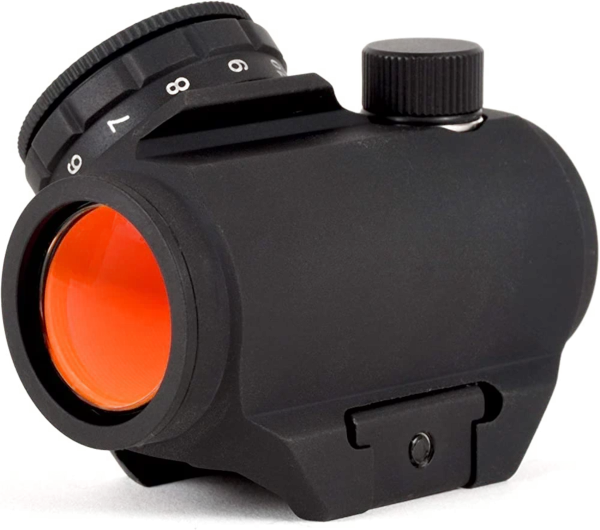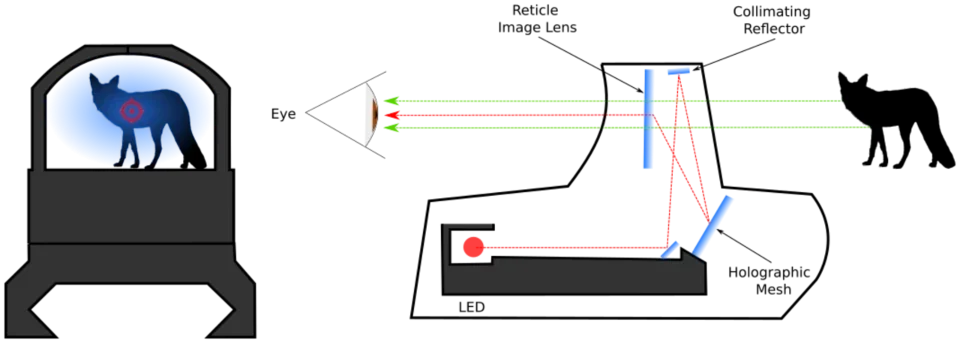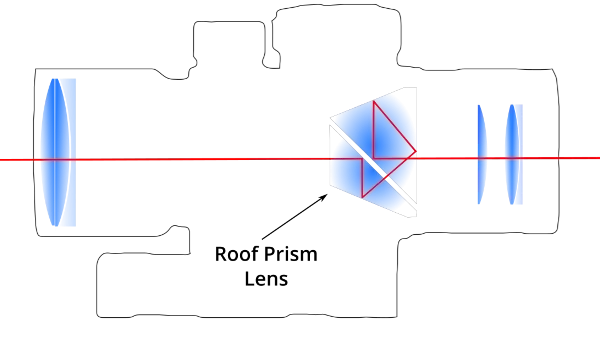

Red Dot Sight
Red dot sights place the target and the reticle on nearly the same optical plane, allowing easy and quick target acquisition. The Bindon Aiming Concept (BAC) is made for this type of sight.
Table of Contents
Red dot sights place the target and the reticle on nearly the same optical plane, allowing easy and quick target acquisition. The Bindon Aiming Concept (BAC) is made for this type of sight.
Definition of a Red Dot Sight
A red dot sight is an optic sight that displays an illuminated aiming point (reticle) for the operator that is superimposed on the field view. They generally have little or no magnification and as such, and are used mainly on targets at close to medium ranges.
The Bindon Aiming Concept (BAC)
The Bindon Aiming Concept (BAC) is the concept of shooting with both eyes open. Developed by Glyn Bindon, the founder of Trijicon. Glyn noticed that when both eyes are open and the firearm is moved if there is a bright enough light in the reticle field, one eye will see the lit reticle inside the sight, while the other eye takes in the target and area around it.
Read more about it here: Trijicon
Types of Red Dot Sights
While we have described a red dot sight. The term “red dot sight” actually covers several different types:
- Reflex Sights.
- Holographic sights.
- Prism Sights.
Reflex sights
Unlike conventional sights where the front and rear sights must be in perfect alignment to target correctly. Reflex sights can be used from different eye positions without adversely affecting the aim. This can allow for enhanced peripheral vision which can come in handy at close quarters or in dense scrub.
Important to note that these sights are passive, that is they do not shine a laser on the target.
Magnification
Reflex sights typically have no magnification. Sight magnifiers (optical telescopes) have been used in conjunction with reflex sights and holographic sights. These are mounted so that they are flipped aside when not in use (sometimes referred to as “flip in” sights). Can be useful when hunting in thick scrub.
Parallax
Reflex sights are not totally free of parallax. However, as the sight is close to the same focal plane as the target and it is mainly used at short to mid ranges, it is not a notable factor.
History
Howard Grubb, later to become Sir, an optical designer from Ireland, came up with the concept of the reflex (reflector) sight in 1900. He patented the idea as “Gun sight for large and small Ordinance”. The sight was used on everything from surveying equipment to fighter aircraft.
It was the 1970s that saw the emergence of the red dot sight. Low power LED’s greatly improved the reliability and battery life of the sights and brought wider adoption.
Types of reflex sights
Reflex sights are divided into two subcategories:
- Exposed reflex sights
- Tube reflex sights
Exposed Reflex Sights
Exposed reflex (reflector) sights are relatively simple. A very bright LED (light-emitting diode) shines onto an angled lens which reflects the light to the user’s eye.

Tube Reflex Sights
Tube reflex sights work in a similar manner. They resemble a short riflescope and the LED is contained within the tube. These sights usually have a reticle that can be selected to illuminate by battery power of fibre optic-fed natural light.

Holographic Sights
Holographic (holographic diffraction) sights use a hologram as a reticle. The reticle image is transmitted by laser and typically uses a rectangular field of view as opposed to the conventional circle. The reticle appears at the target’s focal plane (it is like the reticle is on the target). These sights have a great field view and, like reflex sights, allow the shooter to move their eye position without moving their aim.

Magnification
Holographic sights generally have no magnification.
Parallax
As with reflex sights holographic sights are not totally free of parallax error but it is markedly less than conventional scopes.
History
Developed and manufactured by EOTech. Bushnell, using the trade name Holosight, introduced the first generation of holographic sight in 1996. EOtech was the sole manufacturer of the sights until Vortex joined the party in 2017.
Prismatic Sights
Prismatic sights are like a conventional rifle scope but use a roof prism to erect the image of the target instead of an erector lens array. In the majority of prismatic sights, the reticle is etched directly into one facet of the prism glass and can be illuminated from the rear of the prism.

Magnification
The magnification on prismatic scopes is generally fixed or has low multipliers (2x, 3x, 4x and 5 x) making them more suited to short to mid-ranges.
Parallax
Unlike the reflex and holographic sights, the prismatic sights are like using a conventional riflescope where correct eye relief is again critical. They also can suffer from parallax errors.
History
Prism binoculars have been around since the late 1800s. It wasn’t until a prismatic scope sight was developed by the Warner and Swasey Company for World War I that prismatic scopes came into being.
It wasn’t until 2010 that Vortex and Trijicon started making prismatic scopes for civilian applications.
Red Dot Sight Pros and Cons
Pros
- Increased field of view
- Increased peripheral vision
- Little parallax error
- Better low-light performance
- Easier target acquisition
Cons
- Can be expensive
- Limited magnification options
- Susceptibility to damage or battery failure
- Can be bulky in some cases
FAQ (Frequently Asked Questions)
How accurate are red dot sights?
It does of course rely mainly on the nut behind the bolt. However many users of red dot sights shoot better than with open sights.
Can red dot sights be used with magnifiers?
Yes. Sight magnifiers or “flip in” optics are available and are generally mounted to the rear of the red dot sight.
Are all red dot sights compatible with all firearms?
Red dot sights can be used on any firearm with an appropriate mounting system such as a Picatinny rail.
How do I choose the right red dot sight for my needs?
Horses for courses. Red dot sights are good at short to mid-range. Have fast target acquisition and have little parallax error.
If your needs suit those requirements then the next step is to check some out. Decide on your budget and trip to the local store and actually look through the sight. They don’t suit absolutely everyone.
Lastly, keep in mind they mostly require power to operate so check out the battery life and cost of such items.
How often do I need to replace the battery in my red dot sight?
The average battery life for a red dot sight is around 500 hours.
This can vary from 20 hours to over 150000 (advertised) hours depending on the brand and make of the unit and its use.
Be smart and switch the unit off when not in use. Use quality batteries and you should see some good life from them.
Some people switch their batteries every year, regardless of use, just to be sure
Can red dot sights be used in competition shooting?
Red dot sights are popular in some competitions and are allowed to be used. There are exceptions of course so check with the organizers.
Can red dot sights be used for hunting?
Yes. Red dots are used widely in hunting, particularly at close ranges. They are also very popular on shotguns.